The 2013 MacBook Air Review (13-inch)
by Anand Lal Shimpi on June 24, 2013 12:01 AM ESTAbsolutely Insane Battery Life
With Haswell ULT, Intel aggressively focused on driving down total platform power consumption. It turns out that although Intel did a wonderful job of driving down CPU power consumption over the years, it did nothing to make the rest of the platform keep up. With Haswell ULT, all of that changed. Intel is being frustratingly cagey with giving up real details on exactly what’s going on with Haswell ULT, but here’s what I’ve been able to piece together.
For starters, Haswell ULT brings the PCH (Platform Controller Hub) on-package. The PCH is responsible for all SATA, USB, PCIe 2.0 and other rest-of-system interfaces. Bringing it on package reduces the amount of power needed to drive traffic between the CPU and PCH, which in turn helps reduce platform power.
The PCH also moves down to 32nm, helping further reduce power consumption. Haswell ULT silicon itself is binned for lower voltage/power operation. The combination of Haswell ULT CPU and PCH are both included in the new 15W TDP (there’s a 28W version as well but not used in the MacBook Air).
Haswell ULT supports lower power sleep states (up to C10) than the standard mobile or desktop parts (C6/C7).
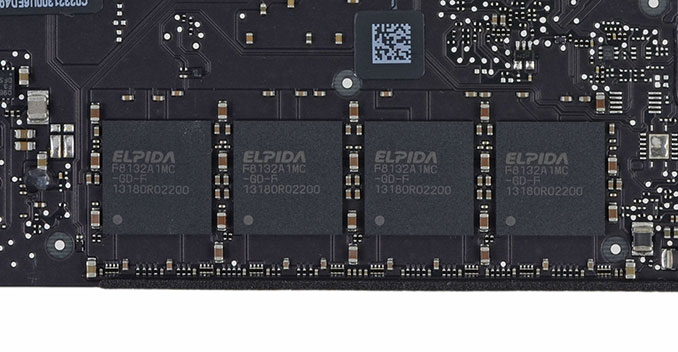
Image Courtesy iFixit
The other big change, and one that Apple is among the first (only?) to take advantage of is Haswell ULT’s support for LPDDR3. Standard DDR3 operates at 1.5V, while low-voltage DDR3L drops that down to 1.35V - the two standards are otherwise identical. LPDDR3 on the other hand drops voltage even further (1.2V) while introducing architectural features to drive power down even lower. LPDDR3‘s power advantage is why it’s frequently used in smartphones vs. DDR3L. The biggest downside is cost. Apple has historically not had an issue with spending a bit extra to get a better overall experience, so it’s not surprising to see the MacBook Air ship with LPDDR3.
Overall bandwidth remains unchanged despite the move to very low power memory. We’re still dealing with a 128-bit wide memory interface with a 1600MHz datarate. Note the impact this has on DRAM device layout on the PCB itself. Last year's model required 16 DDR3L devices, compared to 4 x 32-bit LPDDR3 devices here. Anyone else smell laptop/tablet convergence coming this way?
Haswell ULT also enables support for Intel’s Power Optimizer framework. I’ve talked about this extensively over the past several months, but it’s effectively a messaging system that allows all devices/controllers within a system to coordinate going into sleep states during periods of idle time. Of all of the platform power optimizations, this is the only one that isn’t currently taken advantage of in OS X. You’ll have to wait for OS X Mavericks to realize these gains.
Apple also boosted overall battery capacity on the MacBook Airs by roughly 8%. The increase in battery capacity had no impact on weight. Although it’s not immediately apparent, I would assume that Apple’s new SSDs also support DevSleep (DEVSLP) and Runtime D3.
The result of all of this is a downright tremendous improvement in battery life. OS X already did very well in the idle power department. Haswell’s FIVR (Fully Integrated Voltage Regulator) can more quickly/aggressively enter and exit low power states. The combination of which is really the perfect storm for increasing battery life.
On the 13-inch MBA, Apple claims up to 12 hours of usage on a single charge.
Apple even revised its own testing in order to make its quoted battery life numbers more realistic. Previously it ran all of its own battery life tests at 50% brightness, but starting with the MacBook Air Apple’s quoted battery life numbers are at 75% brightness. Our tests by comparison are at 81.5% (200 nits on the MBA). Apple’s changes to its battery testing methodology actually tend to unintentionally mirror ours. Our first Mac battery life tests ran at roughly 50% brightness (100 nits).
So how did the MacBook Air fare in our testing? To find out I turned to our updated 2012 battery life test suite, first introduced with the 15-inch rMBP review.
The light and medium suites are inherently related - they use the same workload and simply vary the aggressiveness of that workload. The light test hits four different websites every minute, pausing for nearly the entire time to simulate reading time. Flash is enabled and present on three of the sites. The long pause time between page loads is what really makes this a light test. Web browsing may be the medium for the test but if all you’re doing is typing, watching Twitter update and maybe lazily doing some other content consumption this is a good representation of the battery life you’ll see. It’s a great way of estimating battery life if you’re going to be using your notebook as a glorified typewriter (likely a conservative estimate for that usage model).
The medium test hits the same webpages (Flash and all) but far more aggressively. Here there’s less than 10 seconds of reading time before going onto the next page. It sounds like a small change but the impact on battery life is tremendous.
Both the light and medium tests are run in their default state with processor graphics enabled, as well as with the discrete GPU forced on. I run with the dGPU on as well because it’s far too often that a single application open in the background will fire up the dGPU and contribute to draining your battery. The goal here is to deliver useful numbers after all.
The final test is very similar to our old heavy multitasking battery life tests, but with some updates. Here I’m downloading large files at a constant 1MB/s from a dedicated server, while playing back a looped 1080p H.264 movie (the Skyfall trailer) all while running the medium battery life test. The end result is a workload that gives you a good idea of what a heavy multitasking usage model will do in terms of battery life. I’ve found that OS X tends to fire up the dGPU anyway while running this workload so I saw no reason to run a separate set of numbers for processor and discrete graphics.
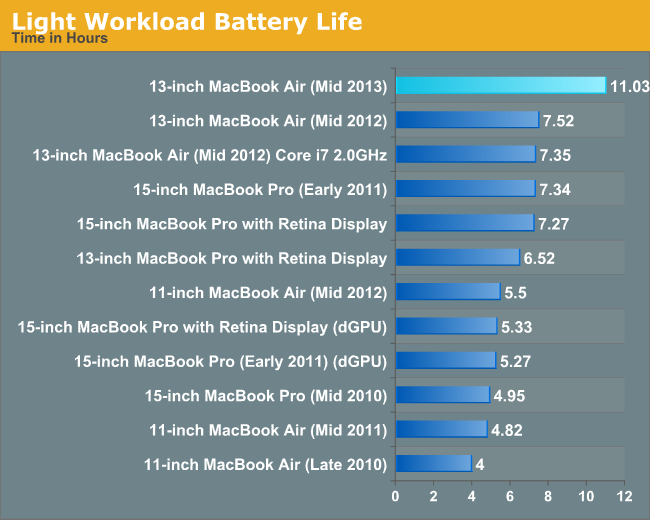
This is just ridiculous. Apple claims 12 hours, we tend to test a little more strenuous than Apple does and ended up with just over 11 hours of battery life on a single charge. These highly idle cases end up dominated by display power, which is why we actually see the smallest improvement in battery life over the previous generation here (~35%, normalized for battery capacity). If you drop brightness down to something more reasonable (~100 nits) you’ll get some truly insane numbers:
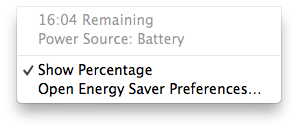
I remember owning a Transmeta Crusoe based Sony Picturebook (C1VN) with an extended battery and being able to break 14 hours of battery life. I had to give up so much performance and usability to get that sort of battery life back then; with the new MacBook Air, I don’t have to.
Now this is really the sort of battery life you can expect when using the 13-inch MBA as a glorified typewriter. What happens if you start using the system a bit more aggressively?
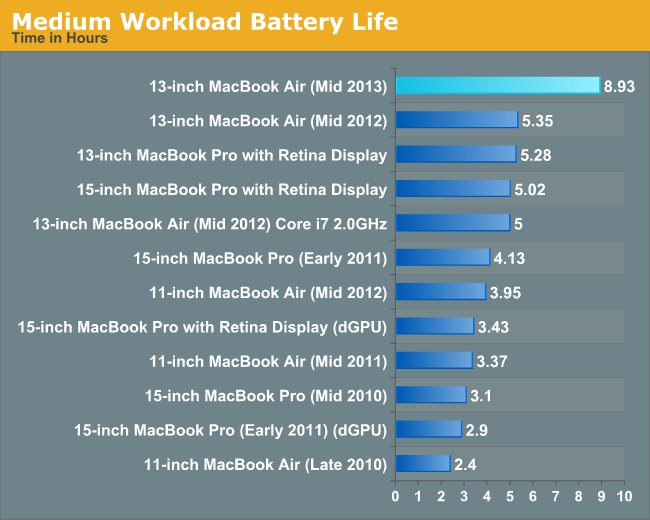
Just under 9 hours on a single charge, an increase of 54.5% when you normalize for battery capacity. What the world would’ve done if Haswell ULT hit prior to the creation of the iPad...
The reason I create/present three different battery life tests is to showcase a range of expected battery life. No one number is going to characterize what you can expect out of the system, but my hope is you’ll get a good idea of range by looking at the numbers here. The heavy test used to provide a good look at worst case scenario, but I’m beginning to wonder if I need something even more stressful:
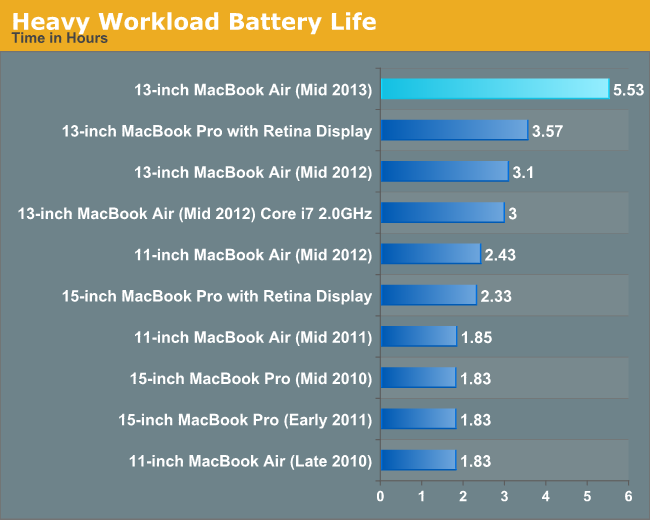
Even normalizing for battery capacity changes, the new 13-inch MacBook Air increases battery life by 65% over the previous model.
Under really heavy use (think tons of video/photo editing work) you can go even lower than what our heavy workload numbers show. In my experience I found that around 7 hours of battery life on a single charge is reasonable for most of my workloads, but when doing a lot of work (tons of Flash tabs open, compiling a project in the background and heavy multitasking) I could kill the 13-inch MBA in under 4 hours.
The benefit of the new MBA is really in its ability to extend its battery life when needed. Close Safari windows, turn down the brightness, and you’ve got a machine that can last for a very long time without needing a wall outlet. There's a good reason that OS X Mavericks focuses so much on putting background tasks/apps to sleep, maximizing idle time is really the key to getting this insane amount of battery life.


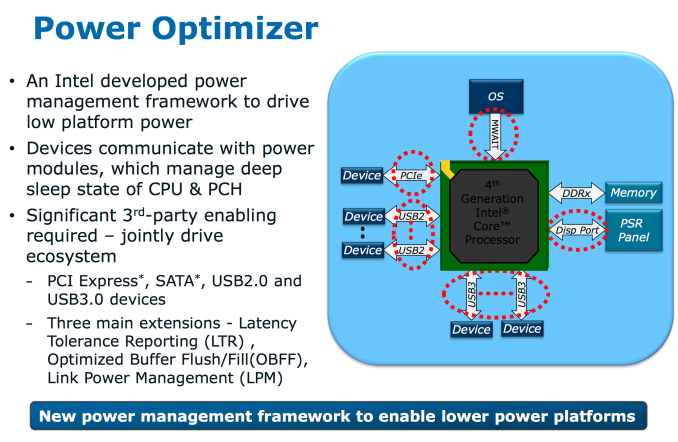








233 Comments
View All Comments
lilo777 - Monday, June 24, 2013 - link
It would help if you disproved something that was so wrong in my post. Perhaps people using OSX in their names are simply incapable of recognizing any Apple bias?akdj - Thursday, June 27, 2013 - link
In the ultra book market... and this price point....there aren't a lot of excellent choices right now for displays. If you step up to $1500-$1800...yes, one or two of the UltraBook vendors are selling 1080p IPS panels. At this price though...in the 'true' UltraBook sense of the word....go shopping at Best Buy sometime. Take a look at what Dell, Toshiba, Samsung and others are offering....again @ $1099. Asus is honestly the only one, in my opinion...that you can buy odd the shelf that competes. Period. You're right...it's time we get a 'better' panel. Perhaps 2014 will bring IGZO technology and production up to speed...IPS prices drop a bit...and Apple decides to equip a higher quality display. I'm all for it. But the current displays don't suck. They're excellent for what they are and at the current 'price point' you can't get that killer high rez panel from Sony. As well...at this size 11"), unless you double the resolution and pixel double as in the rMBP...raising the default resolution too much and text, icons, etc become to small. I'm always amazed at how much real estate I actually DO have on my 11" Air (2011)....in apps with 'full screen' capability....and until I bought the rMBP 15" last summer...I only used 17" MBPs!TheinsanegamerN - Sunday, June 30, 2013 - link
everyone overlooks something else with the 13 inch air's display...it's 16:10. which is amazing. i'd gladly take this over 16:9 anyday. wish more oems would go back to 16:10. and having seen the screen, and with a bias against macs...i kinda want one of the new airs.darwinosx - Monday, June 24, 2013 - link
The display is not glossy. Read the article you are commenting on.lilo777 - Monday, June 24, 2013 - link
You do not need to read the article to know that all Apple displays are glossy. It seems you do not even know what matte display looks like.Sm0kes - Monday, June 24, 2013 - link
Apple's Macbook Air lineup, while not as "glossy" in appearance as the Retina Macbook Pro's do still have a glossy coating. As a long time hater of glossy displays on notebooks, I have no issue with my Air.amrs - Tuesday, July 23, 2013 - link
No WWAN either. I think I'll upgrade my Thinkpad X201 to an X240s when those come out if it's any good. With matte display and 3G/4G inside too. Just the basics for mobile usage really.Strulf - Monday, June 24, 2013 - link
1920 x 1200 certainly would be nice. I want to upgrade my 2009 MBA but I'm gonna watch for the next revision - hopefully with a higher resolution then.thinkpanda - Monday, June 24, 2013 - link
I would like to share a few experience regarding to WiFi performance.I am using late 2011 MBP 13", which should support 3x3 802.11n. I connect home devices with Asus RT-AC66U router. I have a home server of Ubuntu Server 12.04 LTS, with Realtek 8168 GB Ethernet chip connected to the router. The home server has netatalk service installed to support AFP so that I mount the home server storage from MBP using AFP.
When I copy file from server to my local SSD (just by dragging the file at Finder), I get file transfer rate of 39MB/s! This is not even an AC network, just N network.
So I am curious that is it the server size TCP windows size settings affect the performance, and the OS X as client device is not affect at all ?
mikk - Monday, June 24, 2013 - link
"It’s hilarious that Intel refused to give out die photos for anything other than quad-core Haswell GT2, citing competitive concerns, yet at Apple’s WWDC launch of the new MacBook Airs we got to see the first die shot of a dual-core Haswell GT3"Anand you are plain wrong here. Bad job! ULT GT3 photos are available from Intel since weeks!!!
http://download.intel.com/newsroom/kits//core/4thg...
http://download.intel.com/newsroom/kits//core/4thg...